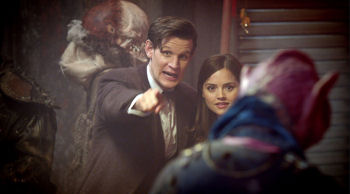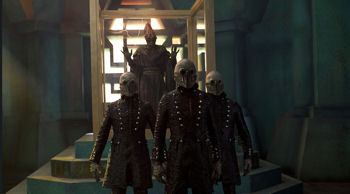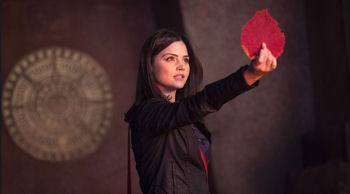The Doctor and his brand new companion, a pretty white woman in her early twenties, take their first real trip in the TARDIS. They travel both in space and time, arriving in an unfamiliar society with strange rules. Right away the companion wanders off and befriends a young girl who is afraid of an ominous secret this society conceals. Later they team up with a queen in a red cloak to evade the sinister robot-like creatures patrolling the area and get to the heart of the secret, which concerns an ancient leviathan described in terms obliquely reminiscent of the Doctor himself and feared for its tendency to swallow people. The Doctor tries to defeat the leviathan, but at the last moment his companion has a flash of inspiration and, with some quick lateral thinking, saves the day.
Yes, it’s “The Beast Below.” And it’s also “The Rings of Akhaten.”
This is more remarkable than terrible, given that this is Neil Cross’s Doctor Who debut and not Steven Moffat plagiarizing himself again, and since, despite some reservations, I liked “The Beast Below.”
Where that was political, this is spiritual, giving us a spurious creation myth (which the Doctor calls “a nice story” and later replaces with another about how we’re all born from stardust), an alleged god that turns out to be an enormous “vampire,” and a ceremony of worship that turns out to be a ritual of sacrifice. On paper this could seem exciting enough, depending on how you feel about watching false gods being debunked and defeated.
 On screen, it’s a bit of a mixed bag. There’s a fairly impressive parade of creature effects and costumes, surely among the most elaborate and numerous aliens we’ve ever seen on the show, though it’s quite a lot of trouble to go to given how little they actually have to do with the story. They’re mainly there so the Doctor can exchange comical “handshakes” and make embarrassing barking noises that are even less convincing than “speaking horse” or “baby.” Two of these creatures, the Vigil and the “mummy,” rank among the scariest we’ve ever seen on the series, but unfortunately the role they play is also vanishingly small.
On screen, it’s a bit of a mixed bag. There’s a fairly impressive parade of creature effects and costumes, surely among the most elaborate and numerous aliens we’ve ever seen on the show, though it’s quite a lot of trouble to go to given how little they actually have to do with the story. They’re mainly there so the Doctor can exchange comical “handshakes” and make embarrassing barking noises that are even less convincing than “speaking horse” or “baby.” Two of these creatures, the Vigil and the “mummy,” rank among the scariest we’ve ever seen on the series, but unfortunately the role they play is also vanishingly small.
Then there’s yet another gratuitous motorbike sequence, in which the Doctor and Clara zip through space without any visible breathing apparatus (presumably they’re not really that far from the pyramid and there’s an atmosphere that contains both). And there’s quite a lot of singing, only a little of which is kind of nice and none of which sounds all that mystical given that the lyrics seem taped together from the contents of Tim Rice’s shredder.
Even on the second viewing, I wasn’t entirely sure the plot was playing fair with us. The Queen of Years, a young girl called Mary, seems at first to be running from a couple of monks/priests/stage managers who want her to do her song as she’s been trained to. But the Vigil, those spooky cousins of Dr. Kroenen from the first Hellboy film, are also looking for her. She talks as though all she’s afraid of is getting her song wrong, but then later she seems to know she’s to be sacrificed; maybe she’s just more stoic than she seems, at least until the crucial moment.
 And how, exactly, is she to be sacrificed? Does the monk with the killer falsetto feed her soul to the mummy in order to hit the snooze button on the giant god’s alarm clock? Or does the giant god reach out in its sleep and munch its little snack? It’s hard to figure out, and the story does little to make us want to try.
And how, exactly, is she to be sacrificed? Does the monk with the killer falsetto feed her soul to the mummy in order to hit the snooze button on the giant god’s alarm clock? Or does the giant god reach out in its sleep and munch its little snack? It’s hard to figure out, and the story does little to make us want to try.
Mainly it seems concerned with its sentimental themes. We meet Clara’s parents in the pre-credits teaser, and the “page one” remark from last week is explained: the leaf falling at a precise moment is the reason her parents met, and both it and her 101 Places to See book represent the possibilities foreclosed by her mother’s untimely death at 45 (on March 5, 2005, which according to Wikipedia is suggested in “Aliens of London” to be the day Rose began travelling with the Doctor).
We learn that in the Rings of Akhaten, objects with sentimental value are used as currency, and the Doctor rather callously manipulates Clara into giving away her mother’s ring to rent the space moped. This is doubly obnoxious because (a) he’s carrying and occasionally wearing Amy’s reading glasses, so even if you assume he has nothing else in the TARDIS that qualifies, his claim that his sonic is the only other option is plainly a lie, and (b) surely the TARDIS is a better tool for this rescue than a space moped anyway (see “The Time of Angels” for just one demonstration). So maybe we’re meant to assume that he’s testing Clara, but if she’s feeling tested, she keeps a poker face about it.
Then of course we have the nature of the old god/vampire itself, a planet-sized creature that apparently eats stories and memories. Mary claims to know all of her people’s stories and histories, so it’s clear why “Grandfather” would want to consume her. The Doctor offers the creature all of his own memories (which apparently include both the beginning and the end of the universe), but it’s hard to tell whether the creature actually eats them because the Doctor seems little worse for wear after this offer.
 And finally Clara offers the leaf, overloading the old god with the much larger set of memories that her mother never got a chance to make. It’s a fine enough twist, but a little bloodless; for all the emotion this offering seems to cause Clara, she might as well be giving a Sunday school lecture.
And finally Clara offers the leaf, overloading the old god with the much larger set of memories that her mother never got a chance to make. It’s a fine enough twist, but a little bloodless; for all the emotion this offering seems to cause Clara, she might as well be giving a Sunday school lecture.
In the end, it’s not clear how to put all these elements together into a satisfying whole. There’s spectacle, as impressive as anything we’ve ever seen in 50 years of Doctor Who; there are speeches, verging on self-parody but not much worse than any others we’ve had; there are big subjects, appropriate themes for this show that have never been done quite this way before.
But if “The Bells of St. John” added up to more than the sum of its parts, this story (also about an inhuman entity bent on consuming the lives and souls of humans) somehow adds up to less.
Clara Watch:
- There’s virtually no suggestion in this episode that the Doctor is in love with Clara. Here he seems to regard her as a ward, a student of sorts, and a mystery, and little beyond that. Either Moffat didn’t intend for “The Bells of St. John” to be nearly as flirty as it seemed, or he just didn’t see fit to suggest that the other writers add this element to the relationship.
- Presumably the reason why Clara doesn’t think to look for a spare key above the door of the TARDIS is that we’re meant to see what happens when she tries to open the doors by pushing on them. Namely: nothing. We’ve never ever seen this work in the history of the show, but here it’s supposed to give us the interesting impression that she’s right when she suspects the TARDIS “doesn’t like her.”
Classic series watch:
- The Doctor’s line about his granddaughter isn’t a throwaway, of course, but a reference to Susan, his very first companion back in 1963. Presumably they would have come to the Rings of Akhaten before the Doctor arrived on Earth and enrolled her in Coal Hill School, where she met Ian and Barbara, the other two members of the original TARDIS crew. Did Cross bring up this continuity point as a 50th anniversary year nod? Will it be meaningful later on? Or is it just a way of drawing a connection between the Doctor, whom Susan called “Grandfather,” and the old god who rather improbably has the same nickname? I hadn’t even considered the latter until a good friend pointed it out, but it seems pretty unlikely to be coincidence.
- Not a classic series connection per se, but fans of The Hitchhiker’s Guide to the Galaxy may already know the Hooloovoo as a superintelligent shade of the color blue. Perhaps such creatures, when they need to interact with humanoids, wear protective suits like the one the Doctor points to when he says this name…or maybe the art director just wasn’t in on the joke.
- If you like stories about demigods who rely on the thoughts, memories, and imagination of humans for their own sustenance and amusement, you might try the Eternals from “Enlightenment” or the Gods of Ragnarok from “The Greatest Show in the Galaxy.” It’s probably worth noting that the latter is usually interpreted as an allegory about the relationship of audiences to Doctor Who itself. If this story is driven by some of the same ideas, then it becomes a little more interesting that the “audience” is a creature that requires a pointless but impressive-looking monster to wake it up, that the Doctor’s entire catalog of adventures isn’t enough to satisfy it, and that it takes the relatively parochial pathos of the companion to overwhelm it….

 On screen, it’s a bit of a mixed bag. There’s a fairly impressive parade of creature effects and costumes, surely among the most elaborate and numerous aliens we’ve ever seen on the show, though it’s quite a lot of trouble to go to given how little they actually have to do with the story. They’re mainly there so the Doctor can exchange comical “handshakes” and make embarrassing barking noises that are even less convincing than “speaking horse” or “baby.” Two of these creatures, the Vigil and the “mummy,” rank among the scariest we’ve ever seen on the series, but unfortunately the role they play is also vanishingly small.
On screen, it’s a bit of a mixed bag. There’s a fairly impressive parade of creature effects and costumes, surely among the most elaborate and numerous aliens we’ve ever seen on the show, though it’s quite a lot of trouble to go to given how little they actually have to do with the story. They’re mainly there so the Doctor can exchange comical “handshakes” and make embarrassing barking noises that are even less convincing than “speaking horse” or “baby.” Two of these creatures, the Vigil and the “mummy,” rank among the scariest we’ve ever seen on the series, but unfortunately the role they play is also vanishingly small.  And how, exactly, is she to be sacrificed? Does the monk with the killer falsetto feed her soul to the mummy in order to hit the snooze button on the giant god’s alarm clock? Or does the giant god reach out in its sleep and munch its little snack? It’s hard to figure out, and the story does little to make us want to try.
And how, exactly, is she to be sacrificed? Does the monk with the killer falsetto feed her soul to the mummy in order to hit the snooze button on the giant god’s alarm clock? Or does the giant god reach out in its sleep and munch its little snack? It’s hard to figure out, and the story does little to make us want to try. And finally Clara offers the leaf, overloading the old god with the much larger set of memories that her mother never got a chance to make. It’s a fine enough twist, but a little bloodless; for all the emotion this offering seems to cause Clara, she might as well be giving a Sunday school lecture.
And finally Clara offers the leaf, overloading the old god with the much larger set of memories that her mother never got a chance to make. It’s a fine enough twist, but a little bloodless; for all the emotion this offering seems to cause Clara, she might as well be giving a Sunday school lecture.





